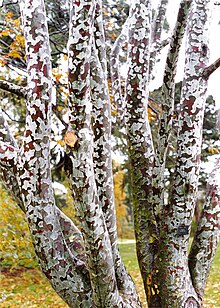Species of conifer Not to be confused with Pinus albicaulis, also called white-bark pine.
| Lacebark pine | |
|---|---|

| |
| Lacebark pine to the east of the Main Hall at Jogyesa (Buddhist Temple) in Seoul, South Korea | |
| Conservation status | |
 Least Concern (IUCN 3.1) | |
| Scientific classification | |
| Kingdom: | Plantae |
| Clade: | Tracheophytes |
| Clade: | Gymnospermae |
| Division: | Pinophyta |
| Class: | Pinopsida |
| Order: | Pinales |
| Family: | Pinaceae |
| Genus: | Pinus |
| Subgenus: | P. subg. Strobus |
| Section: | P. sect. Quinquefoliae |
| Subsection: | P. subsect. Gerardianae |
| Species: | P. bungeana |
| Binomial name | |
| Pinus bungeana Zucc. ex Endl. | |
Pinus bungeana (Chinese: 白皮松; pinyin: báipísōng; Japanese: シロマツ; Korean: 백송; RR: baeksong), also known by the common names Bunge's pine, lacebark pine and white-barked pine, is a pine tree native to northeastern and central China. It is a slow-growing tree that can grow to heights of 15–25 metres (49–82 ft) is frost hardy down to below −26 °C (−15 °F). Its smooth, grey-green bark gradually sheds in round scales to reveal patches of pale yellow, which turn olive-brown, red and purple on exposure to light.

Description
The lacebark pine's trunk can grow either monopodial, as a single growth upwards, or sympodial, forked. Its crown is loosely shaped like a pyramid or umbrella. It has 5–10 centimetres (2.0–3.9 in) long needles in groups of three. Each needles' cross-sections are shaped like a triangular semicircle. The lacebark pine produces cones that turn yellowish brown as they mature and are roughly egg-shaped and 5–7 centimetres (2.0–2.8 in) long. They contain seeds that are grey-brown, slightly egg-shaped, and 10 millimetres (0.39 in) long.

Taxonomy
P. bungeana is synonymous with the name Pinus excorticata, attributed to Lindley and Gordon in William Dallimore's Handbook of Coniferae and Ginkgoaceae. Its name is derived from the surname "Bunge", as one of its early identifications was by botanist Alexander von Bunge in 1831 near Beijing.
P. bungeana is closely related to Pinus gerardiana, another pine species with flaking bark, but P. bungeana has stiffer needles and smaller cones.
Distribution and habitat
Pinus bungeana is native to temperate forests in the mountains of China, but it is also widely cultivated as an ornamental tree, especially for its metallic bark. It grows in the provinces of Shanxi, west Henan, south Gansu, south Hebei, north Sichuan, Shaanxi, west Shandong, and Hubei. It occurs in the wild on limestone rocks and south-facing slopes at relatively high elevations of 500–2,150 metres (1,640–7,050 ft), but has also been planted at lower elevations. In the northern portion of its range, it also occurs in acidic soil. As a light-demanding species, it usually grows in sites less suitable for other tree species.
It was introduced to England in 1843.

Ecology
Pollination of the lacebark pine occurs in the months of April and May, while seeds mature in October and November of the second year.
Uses
In China and Korea, the lacebark pine is traditionally planted near temples and cemeteries. It is also grown as an ornamental tree in classical gardens seeking to imitate Chinese gardens, in which it symbolizes longevity. It can also be seen in botanic gardens and often grows with multiple stems.
The wood of the lacebark pine is not commercially used as timber, but it is used locally by populations in northeast China for construction, furniture, and transport structures like pallets. The lacebark pine has edible seeds used in traditional Chinese medicine to provide relief for respiratory ailments.

Cultural significance
In 2009, P. bungeana was named the city tree of Baoji, China.
References
- ^ Luscombe, D (2013). "Pinus bungeana". IUCN Red List of Threatened Species. 2013: e.T39602A2930000. doi:10.2305/IUCN.UK.2013-1.RLTS.T39602A2930000.en. Retrieved 13 November 2021.
- NRCS. "Pinus bungeana". PLANTS Database. United States Department of Agriculture (USDA). Retrieved 4 October 2015.
- ^ Fu, Liguo; Li, Nan; Elias, Thomas S.; Mill, Robert R. "Pinus bungeana". Flora of China. Vol. 4. Retrieved 16 August 2018 – via eFloras.org, Missouri Botanical Garden, St. Louis, MO & Harvard University Herbaria, Cambridge, MA.
- Earle, Christopher J., ed. (2018). "Pinus bungeana". The Gymnosperm Database.
- Dallimore, William; Jackson, Albert Bruce (1923). "Pinus". A handbook of Coniferae, including Ginkgoaceæ (1 ed.). New York: Longmans, Green & Co. pp. 375–377. doi:10.5962/bhl.title.15657.
- 张红平 (26 April 2009). "海棠花成为宝鸡市市花" [Asiatic apple flower becomes city flower of Baoji] (in Chinese). Sina Corporation. Retrieved 14 February 2023.
Further reading
- Li, B. & W. C. Gu (2002). "A study on phenotypic diversity of seeds and cones characteristics in Pinus bungeana". Biodiversity Science. 10 (2): 181–188. doi:10.17520/biods.2002023.
- Sujuan, Guo; Ling Hongqin & Li Fenglan. "Physiological and biochemical basis of rooting of Pinus bungeana cuttings". Journal of Beijing Forestry University. 2004 (2).